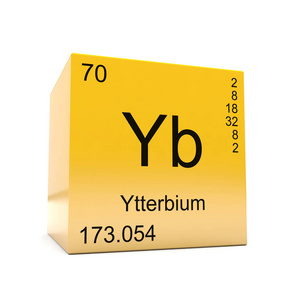Understanding Ytterbium: Essential Properties and Applications
With a bright silvery shine, the rare earth metal ytterbium exhibits soft, malleable and ductile properties. As element number 70 and the fourteenth lanthanide, ytterbium stands apart for its relative stability in the +2 oxidation state, though +3 remains the predominant form. Denoted by symbol Yb, ytterbium reacts slowly with water but dissolves readily in mineral acids, while immediately developing an oxide layer when exposed to air. This thin oxide coating protects the reactive underlying metal. Occurring rarely in nature, ytterbium compounds prove challenging to isolate. Scientists must process ores containing trace amounts to produce pure ytterbium for study and specialized applications leveraging its unique attributes.

Ytterbium occurs in various compounds like oxides and halides. Its closed-shell electron configuration leads to divergent density, melting and boiling points from other lanthanides. Key uses of ytterbium include alloying to improve steel mechanical properties through grain refinement and strength enhancement. Interestingly, ytterbium exhibits the highest volatility of all rare earth metals. Researchers continue exploring additional applications to leverage ytterbium's exceptional combination of attributes, including its reactivity, conductivity and spectroscopic signature.
Source of Ytterbium
In nature, ytterbium occurs alongside other rare earths in select minerals like gadolinite, monazite and xenotime. This element consists of seven stable isotopes. China, the United States, Brazil and India serve as the main sources, mining ytterbium from ores containing monazite, euxenite and xenotime. Despite its rarity and low abundance compared to other rare earths, global ytterbium production still totals around 50 tons annually. Once extracted and processed, pure ytterbium metal poses certain health risks, including potential eye and skin irritation. With judicious handling, ytterbium's unique properties suit it to numerous specialized applications across technology, engineering and science.
Discovery of Rare Earth Ytterbium
In 1878, Swiss chemist Jean Charles Galissard de Marignac isolated a new rare earth oxide called ytterbia from erbia. He named it after Ytterby, the Swedish village where he first separated this component of erbium. Initially believing ytterbia to be a compound rather than pure element, Marignac later termed the proposed new element ytterbium. Scientists struggled for many decades to extract pure ytterbium metal. Finally in 1953, researchers successfully produced a relatively uncontaminated ytterbium sample, enabling more detailed study and applications.
Properties
l Silvery colored, malleable and ductile metal. Oxidizes slowly in air.
l Melting point of 824°C and boiling point of 1196°C.
l Density of 6.9 g/cm3. One of the densest rare earth metals.
l Exists in +2 and +3 oxidation states, with +3 being more common.
l Absorbs neutrons readily, used as a burnable poison in nuclear reactors.
l Used as a dopant to improve conductivity of stainless steel and aluminum.
l Emits invisible near-infrared laser light at 980 nm and 1064 nm wavelengths.
l Spectroscopic transitions used in atomic clocks and magnetometers.
l Oxides used as phosphors in X-ray imaging and scintillators.
l Compounds used in infrared lasers, fibers, and semiconductor substrates.
l Has closed-shell electron configuration leading to unique properties.
Applications of Rare Earth Ytterbium
1. Lasers - Ytterbium-doped solid-state and fiber lasers emitting near-infrared light at 980nm and 1064nm wavelengths. Used for cutting, welding, medicine, communications.
2. Optical fibers- Doping improves efficiency of fiber optic data transmission.
3. Phosphors- Ytterbium oxide used in X-ray detectors, scintillators, and flat panel displays.
4. Alloy additive- Improves strength, workability and corrosion resistance when added to stainless steel.
5. Thin films- Ytterbium compounds used as buffer layers in superconducting films and as gate dielectrics in transistors.
6. Atomic clocks- Spectroscopic transitions of ytterbium-169 used as time references in most accurate atomic clocks.
7. Magnetometers- Measures magnetic fields extremely precisely based on atomic energy transitions.
8. Dental ceramics- Added to ceramics for dental implants and restorations to increase translucency.
9. Cancer treatment- Ytterbium-169 used in targeted radiation therapy for various cancers.
10. Stress measurement- Used to detect stresses and material failures in critical components.
In summary, ytterbium's unique optical, electrical and mechanical properties make it useful in lasers, alloys, electronics, medical devices, and other advanced applications.
Conclusion
With atomic number 70, ytterbium presents as a shiny, silvery, and soft rare earth metal. It occurs naturally mixed with other rare earth minerals and ranks as the most volatile lanthanide. Engineers employ ytterbium to enhance stainless steel's mechanical strength. The element also serves as a dopant in active media and finds usage in various crucial applications that leverage its exceptional properties.
